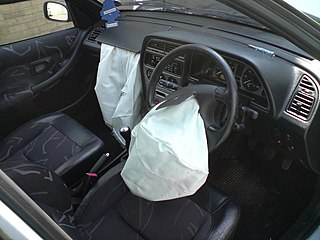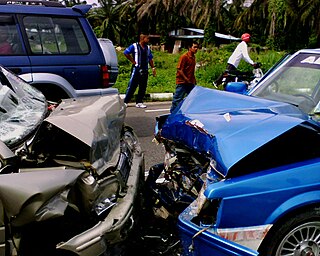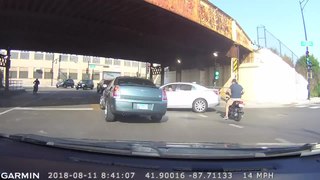
An airbag is a vehicle occupant-restraint system using a bag designed to inflate extremely quickly, then quickly deflate during a collision. It consists of the airbag cushion, a flexible fabric bag, an inflation module, and an impact sensor. The purpose of the airbag is to provide a vehicle occupant with a soft cushioning and restraint during a crash event. It can reduce injuries between the flailing occupant and the interior of the vehicle.

Crumple zones, crush zones, or crash zones, are a structural safety feature used in vehicles, mainly in automobiles, to increase the time over which a change in velocity occurs from the impact during a collision by controlled deformation; in recent years also incorporated into trains and railcars.
Battery is a criminal offense involving unlawful physical contact, distinct from assault which is the act of creating apprehension of such contact.
At common law, battery is the tort of intentionally and voluntarily bringing about an unconsented harmful or offensive contact with a person or to something closely associated with them. Unlike assault, in which the fear of imminent contact may support a civil claim, battery involves an actual contact. The contact can be by one person of another, with or without a weapon, or the contact may be by an object brought about by the tortfeasor. For example, the intentionally bringing a car into contact with another person, or the intentional striking of a person with a thrown rock, is a battery.

Side collisions are vehicle crashes where the side of one or more vehicles is impacted. These crashes often occur at intersections, in parking lots, and when two vehicles pass on a multi-lane roadway.

A single-vehicle collision or single-vehicle accident is a type of road traffic collision in which only the one vehicle is involved. Included in this category are run-off-road collisions, collisions with fallen rocks or debris in the road, rollover crashes within the roadway, and collisions with animals.
Vehicular communication systems are computer networks in which vehicles and roadside units are the communicating nodes, providing each other with information, such as safety warnings and traffic information. They can be effective in avoiding accidents and traffic congestion. Both types of nodes are dedicated short-range communications (DSRC) devices. DSRC works in 5.9 GHz band with bandwidth of 75 MHz and approximate range of 300 m. Vehicular communications is usually developed as a part of intelligent transportation systems (ITS).
Classification of railway accidents, both in terms of cause and effect, is a valuable aid in studying rail accidents to help to prevent similar ones occurring in the future. Systematic investigation for over 150 years has led to the railways' excellent safety record.
Emergency brake assist (EBA) or brake assist is a generic term for an automobile braking technology that increases braking pressure in an emergency. The first application was developed jointly by Daimler-Benz and TRW/LucasVarity. Research conducted in 1992 at the Mercedes-Benz driving simulator in Berlin revealed that more than 90% of drivers fail to brake with enough force when faced with an emergency.

A tram accident is any accident involving a tram. Alternatively, any accident involving a tram or a tram system may be considered a tram accident. The latter definition is more commonly used in public safety studies.
In medicine, an external cause is a reason for the existence of a medical condition which can be associated with a specific object or acute process that was caused by something outside the body. Such causes are classified as "E codes" in ICD 9.

A collision avoidance system (CAS), also known as a pre-crash system, forward collision warning system, or collision mitigation system, is an automobile safety system designed to prevent or reduce the severity of a collision. In its basic form, a forward collision warning system monitors a vehicle's speed, the speed of a vehicle in front of it, and the distance between the vehicles, to provide a warning to the driver if the vehicles get too close so as to avoid a crash. Various technologies and sensors that are used include radar (all-weather) and sometimes laser (LIDAR) and camera to detect an imminent crash. GPS sensors can detect fixed dangers such as approaching stop signs through a location database. Pedestrian detection can also be a feature of these types of systems.

A traffic collision, also called a motor vehicle collision (MVC) among other terms, occurs when a vehicle collides with another vehicle, pedestrian, animal, road debris, or other stationary obstruction, such as a tree, pole or building. Traffic collisions often result in injury, disability, death, and property damage as well as financial costs to both society and the individuals involved.
When a person makes a claim for personal injury damages that have resulted from the presence of a defective automobile or component of an automobile, that person asserts a product liability claim. That claim may be against the automobile's manufacturer, the manufacturer of a component part or system, or both, as well as potentially being raised against companies that distributed, sold or installed the part or system that is alleged to be defective.

An accident is an unplanned event that sometimes has inconvenient or undesirable consequences, other times being inconsequential. The occurrence of such an event may or may not have unrecognized or unaddressed risks contributing to its cause. Most scientists who study unintentional injury avoid using the term "accident" and focus on factors that increase risk of severe injury and that reduce injury incidence and severity.

Worldwide it was estimated that 1.25 million people were killed and many millions more were injured in motor vehicle collisions in 2013. This makes motor vehicle collisions the leading cause of death among young adults of 15–29 years of age and the ninth cause of death for all ages worldwide. In the United States, 40,100 people died and 2.8 million were injured in crashes in 2017, and around 2,000 children under 16 years old die every year. It is estimated that motor vehicle collisions caused the deaths of around 60 million people during the 20th century, around the same as the number of World War II casualties.
International Classification of Diseases, 10th Revision, Clinical Modification (ICD-10-CM) provided by the Centers for Medicare and Medicaid Services (CMS) and the National Center for Health Statistics (NCHS), for medical coding and reporting in the United States. The ICD-10-CM is a morbidity classification for classifying diagnoses and reason for visits in all American health care settings. The ICD-10-CM is based on the ICD-10, the statistical classification of disease published by the World Health Organization (WHO) which replaces ICD-9.

In traffic laws, a hit-and-run is the act of causing a traffic accident and not stopping afterwards. It is considered a supplemental crime in most jurisdictions.

The Motor Vehicles Act is an Act of the Parliament of India which regulates all aspects of road transport vehicles. The Act provides in detail the legislative provisions regarding licensing of drivers/conductors, registration of motor vehicles, control of motor vehicles through permits, special provisions relating to state transport undertakings, traffic regulation, insurance, liability, offences and penalties, etc. For exercising the legislative provisions of the Act, the Government of India made the Central Motor Vehicles Rules 1989.